|
 Stemonitopsis typhina Stemonitopsis typhina
SynonymsComatricha typhoides
Comatricha typhina
Stemonitis typhina
Stemonitis typhoides
Stemonitis atra
BiostatusPresent in region - Indigenous. Non endemic
Images (click to enlarge)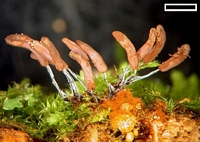
Caption: scale=2mm.
Owner: J.A. Cooper | 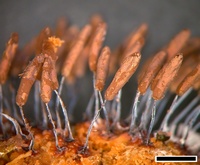
Caption: scale=2mm
Owner: J.A. Cooper | 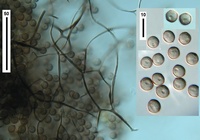
Owner: J.A. Cooper | 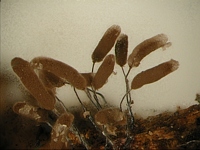
Caption: sporangia
Owner: J.A. Cooper | 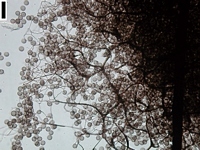
Caption: scale=20um
Owner: J.A. Cooper | 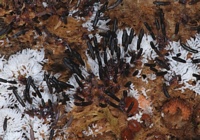
Owner: J.A. Cooper | 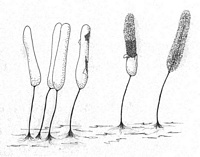
Caption: Sporangia of Stemonitopsis typhina, with the peridium still intact for those on the left. Each sporangium is about 3.5 mm tall.
Owner: S.L. Stephenson |
Article: Stephenson, S.L. (2003). Myxomycetes of New Zealand. Fungi of New Zealand. Ngā Harore o Aotearoa 3: xiv + 238 p. Hong Kong: Fungal Diversity Press.
Description: Fruiting body a stalked sporangium, scattered to gregarious, 2–5 mm high, erect. Sporotheca cylindrical to somewhat ovate and tapering above, erect, dark or purplish brown or occasionally grey, 0.2–0.6 mm in diameter. Stalk slender, dark red to nearly black, typically about half the total height of the sporangium, often covered with a silvery film. Hypothallus contiguous for a group of sporangia, reddish-brown. Peridium membranous, silvery, usually persisting in mature fruiting bodies as scattered patches or sometimes as a shallow calyculus at the base of the sporotheca. Capillitium a dense network of pale brown threads with numerous anastomoses. Spores brown in mass, very pale lilac-brown by transmitted light, faintly punctate with scattered clusters of dark warts, 6–8 µm in diameter. Plasmodium translucently white.
Habitat: Decaying wood and (less commonly) bark.
Distribution: Cosmopolitan (Martin & Alexopoulos 1969), although most common in temperate regions of the Northern Hemisphere. First reported (as Stemonitis typhoides) from New Zealand by Berkeley (1855), based on a specimen collected by W. [and elsewhere]Colenso in Hawkes Bay. Colenso (1887) later reported the species from the same locality. Also known from Auckland, Wellington, Fiordland, Dunedin (Lister & Lister 1905), Southland, the Auckland Islands, and Stewart Island (Lister & Lister 1905). This is the most common species of Stemnitopsis in New Zealand.
Notes: The clusters of dark warts on the spores are usually quite evident and make this a relatively easy species to identify.
|